
It’s my second day in town on this particular visit. I’m on my way to meet with a local scholar for some informal research. We’re arranged to meet at a busy market just after lunchtime. I’m familiar with the other big marketplaces already, which cover all shopping, dining, and grocery needs. But I’m hit by a completely new sensation upon setting foot in this one.
Just a stair climb down from a busy road, we enter a widened alley. The alley morphs into an enlarged intersection. Tents and awnings cover everything. Underneath them is a dizzying assortment of produce, meat, livestock. Small vehicles and every kind of pedestrian fill the street. Tarps, buckets, cages, racks, and makeshift tables occupy the rest of the space. It’s a wet market. I don’t mean to be dramatic about that, there are wet markets all around China. But here, it’s the energy, variety, and freshness of what’s on sale that leaves an impression on me. And a tremendous crowd- I’d have thought half the county was here. I would return to the market several times.
Next to the meat-on-hooks, you can get a haircut. Across the street from a tight line of fresh fruit vendors, you can buy (or slaughter?) live chickens and other caged animals. Red three-wheelers are parked every few feet. Qiang traditional dress is on display at every turn. Meanwhile the mountains fill the narrow backdrops in a way that never fails to stun me.



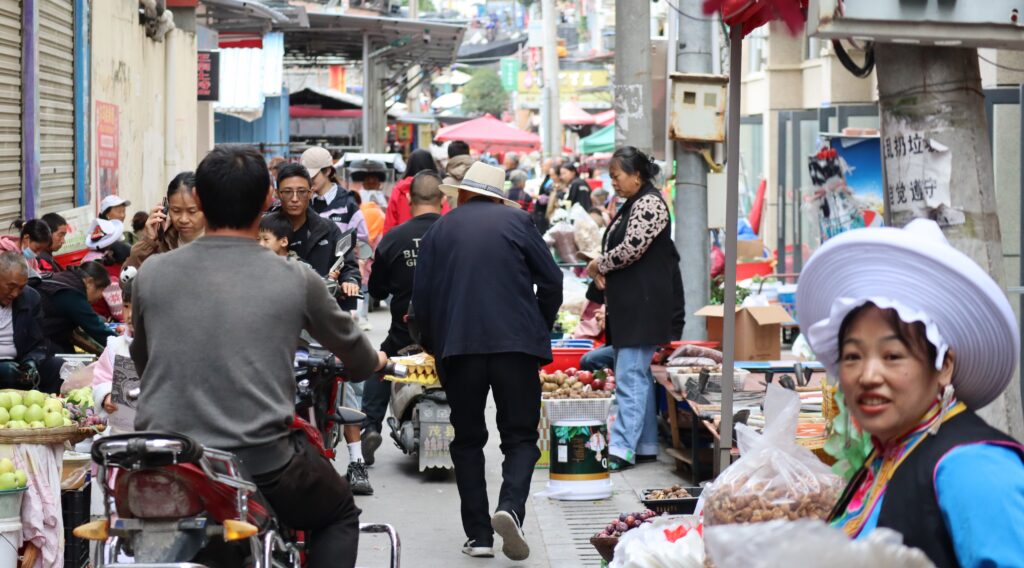
Produce, especially fruit, is at every corner and sidewalk. The full junction includes connecting streets on every side. In the immediate vicinity are stores filled with clothes, trinkets, the usual junk and toys and services.
The meats and animals are contained to fewer spaces. But that meat provokes a flinch. Maybe I’m just too soft. The hanging flesh, organs, body parts… the blood running across the floor into drains… that smell. I play it cool as best I can. Try to act like I’m used to it. It is part of regular life, for many.
In any case, it’s not pretty. Some of the meat I’d rather not know what animal it came from. Be assured this is not some sort of exposé or lecture I am trying to give. I live a comfortable life in comparison and don’t have that right. People have to survive however they can. And I’ve likely deluded myself getting hung up on whatever it is I am trying to do or say. But I guess I’d rather share the culture shock than keep it to myself. I don’t wish to package together only the exciting and profound moments. These nonetheless special places, which I am so fortunate to see, should be shown in an honest and complete way.



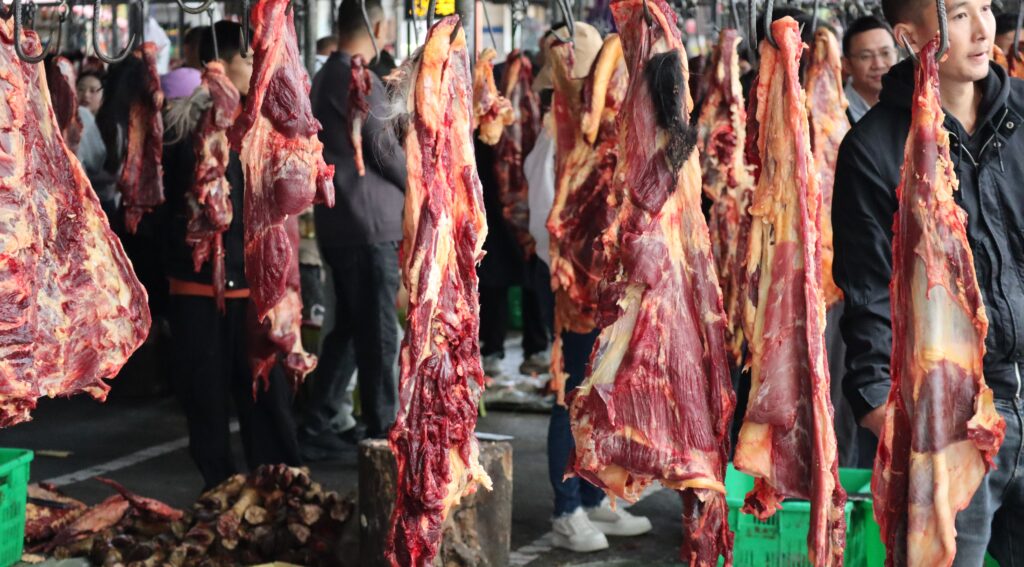

In some ways, the sobering truth maybe fits better with the everyday life that is closer to nature. Authentic living usually involves killing food, right? No need to dress it up. As opposed to buying something that’s been caged, processed, packaged, then frozen (usually with some chemicals). I don’t know, just ranting.
There are plenty of the usual pets running around, for what that’s worth. Dogs and cats. Lots of toy dog breeds on leashes. Tinier animals too, like hamsters, rabbits, goldfish and turtles, are sold from cages and buckets as pets for kids. Probably lacking humane parts of the process, but business is business. What I will say is that I think there are at least more pets being “cared for” (e.g., well behaved dogs being walked with leashes) than there were 15-20 years ago. But that’s my personal anecdote with a very partial memory.
Anyway, it’s only just a part of the picture. While much of Maoxian is genuine countryside, the urban streets in Fengyi resemble something increasingly becoming denser and more comprehensive. With that, more distinct neighborhoods and social groups come into focus.
The next street over could be chain restaurants and storefronts. The street on the other side might be a narrow alley with ample local goods, or a residential neighborhood.




It’s good exercise and quite stimulating to walk around and map stuff mentally. Lots of “aha” moments for me connecting places together.




Much of the material on my site has focused on the rivers, the mountains, the bridges, the habitats. Which I wonder what sort of picture that paints. There is this cliché of “rural mountain life”. A tough, yet simple and nourishing and secluded affair. It’s easy to see examples of this get boosted on social media.
That authentic tone and the folks that embody it remain a deep presence, nonetheless. And the stunning environment, which is a breathtaking reminder of it, is impossible to ever conceal. But Maoxian is a living and evolving place. It is so evident in Fengyi, where modern life is on clear display: constant activity, contemporary drama, colorful light. Fengyi is a city center, a downtown, tangled and complex. At times, astonishing- for better or worse, I have more posts on Fengyi and its neighborhoods to write.
But I don’t believe regional identity has ever been one-sized… there have always been individuals who gave everything to send their kids “to the city” for generations. That city might have been Chengdu, or even Fengyi nowadays. And there are always those who prefer to stay close to the domain, deep in the mountains, to preserve customs and lifestyle. Maybe the balance of those beliefs goes back and forth over time. Interestingly, while Fengyi is home to many Qiang, there are other minority groups here. And that has likely been the case for a long time (records are quite unreliable so I am giving my perception here). So surely, there are many ways of thinking and living, and it’s probably been the case for a while.
In my eyes, that’s what makes all this stuff so worth seeing in different ways. I can easily buy a hat here with the letters “NY” or “LA” on it, and I can also find many kinds of traditional Qiang style headdress. Yet I can’t find a hat that just says “Maoxian” on it!

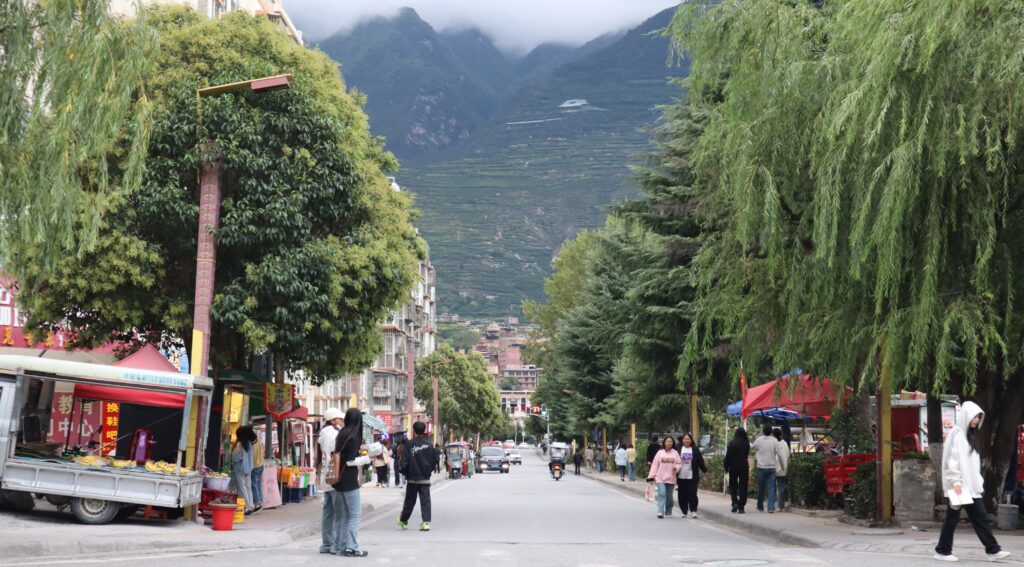


At night, the market dies down. But the buzz is elsewhere. Adjacent streets host dancing crowds, shopping, eating. Music blasts while fumes emanate from food vendors. The music is loud, a blend of lively modern dance and traditional Chinese.
While there is multiple “dancing squares”, they appear to be the same scene. Participants form a circle and move with the fast beat. Many dancers wear Qiang dress. If they are dressed so, they tend to be older. I see young people in modern fashion joining in too. It’s usually women, and kids.
Past midnight, the dancing is over, the only sound still is chatter, and the streets are almost empty. But a few food stalls and late-night restaurants operate. Certain groups keep these places crowded.
Throughout all of it, individuals and small groups wrap up a hard day’s work. Closing their shops and restaurants or making their way home coolly. Hard workers.

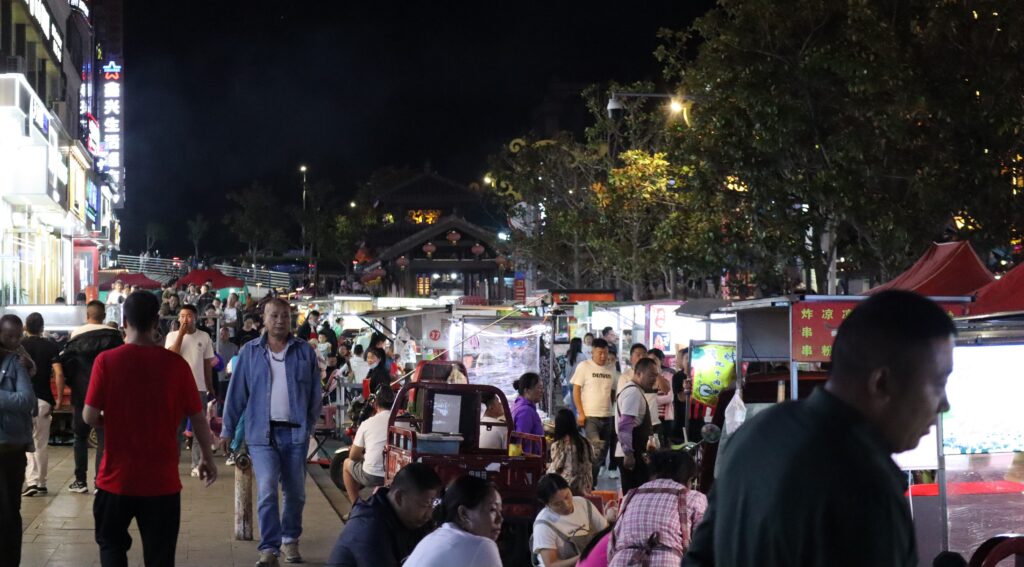

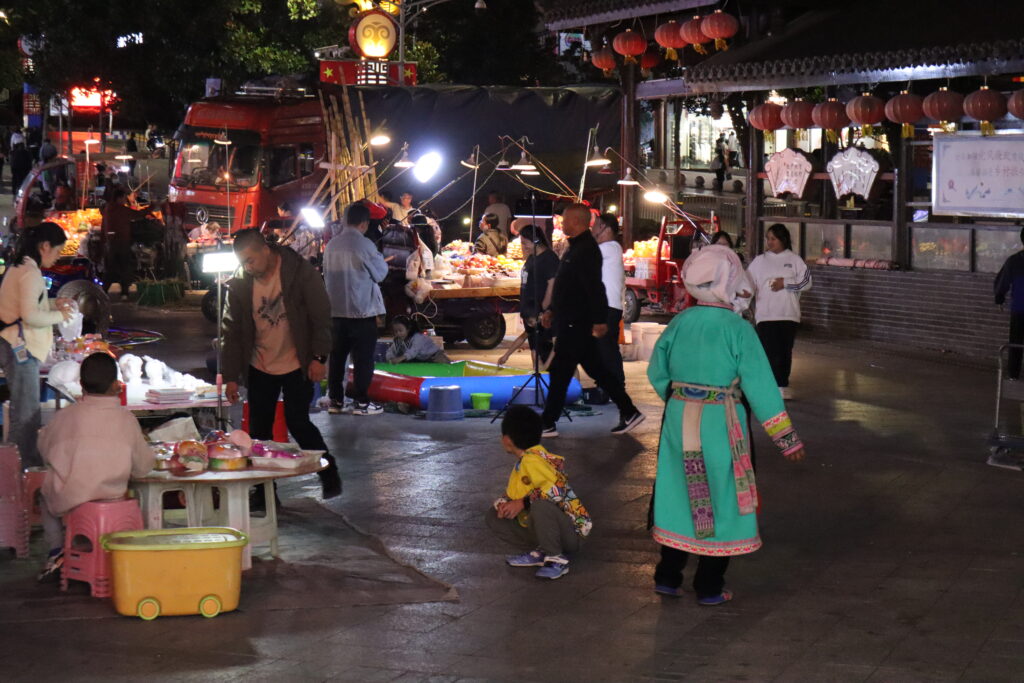
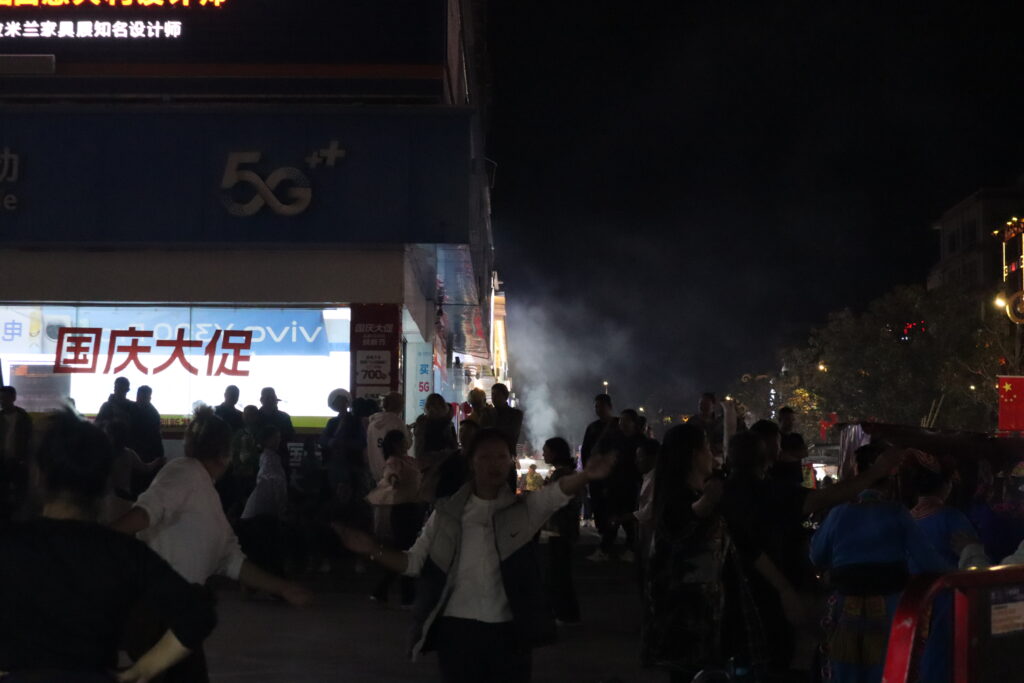



So many lives and stories must cross paths in these streets. I know I am guilty of romanticizing… but I equate these scenes to the moody underbelly of a trendy city. For the record, I don’t like the exact definition of “underbelly”, it’s a bit implicative. I just can’t think of a better term to describe the bustle and atmosphere though.
Safety is hard to measure. I never had a hint of trouble when I walked alone in the alleys, even later at night (maybe they know who my cousin is… or they see the New Yorker in my gait…). But one might want to reference local advice, and general caution, ahead of my experience.
At the very least, there’s a lot of illumination. Stay close!




Chinese BBQ spots stay open quite late- with drinking if desired. When hunger strikes after hours, it’s certainly worth having. It’s Sichuan style, similar to what one can have in Chengdu. Yak meat is a special option here, though. As a side note, I really enjoyed the food overall whilst staying in Fengyi/Maoxian (spicy & Sichuan).
I never really explored bars or pubs or KTV. Not sure how late those places remain open and lively. Doesn’t seem to be a huge scene, but I really haven’t looked. There seems to be something I’m missing; I just don’t know what it is.








A few months ago, I wrote about urbanization in Fengyi, “The Urban Heart of Maoxian“. That was very much a brief overview of Fengyi, with a slight emphasis on its rapid development.
This post is meant to be a deep dive into the market district and its busy streets. But Fengyi has more neighborhoods and themes of interest- which I will cover.
So that is my tiny glimpse into a bustling town in the mountain countryside. It is numerous environments and structures and attitudes mixed together. Raw yet modern… and engaging!
Maoxian is of course bigger than Fengyi, keep in mind. And I’d like to examine through a more cultural angle next.

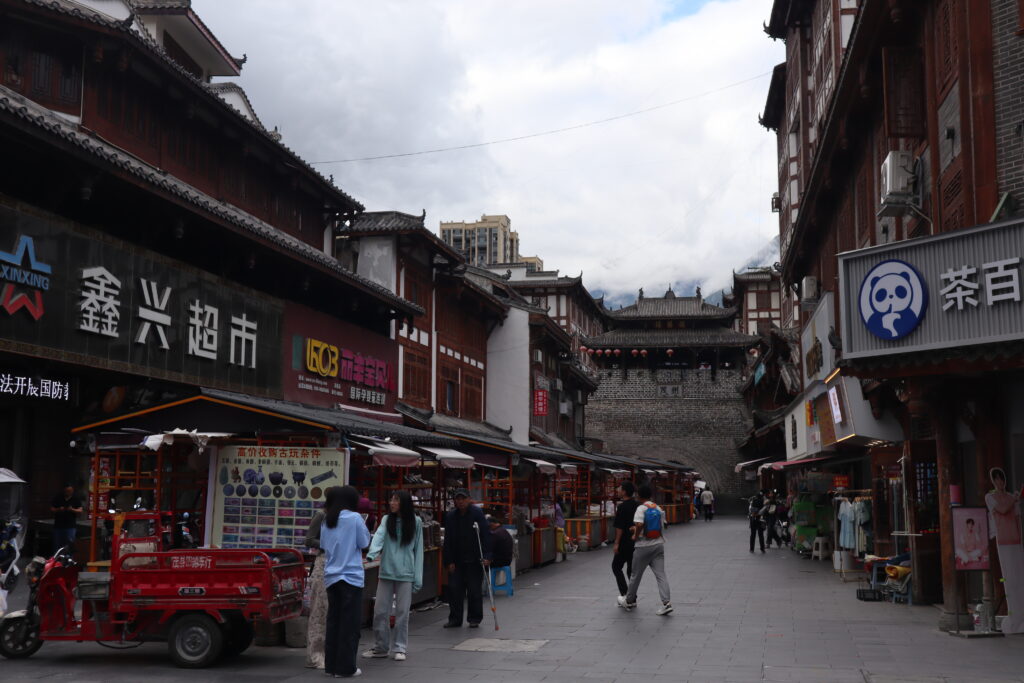









Leave a Reply